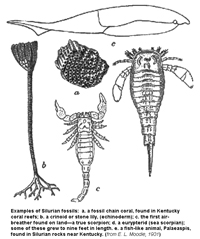2.11: Silurian Period (444-419 million years)
- Page ID
- 9779
Silurian Period (444-419 million years)
Few rocks of Silurian age are preserved in North America's fossil record (they are either not preserved or are not exposed at the surface). Some sedimentary rocks of Silurian age are preserved in upstate New York, around the Cincinnati Arch, and around the margins of the Michigan Basin are notable exceptions. Large fossil pinnacle reefs occur around the margins of an ancient sea basins that covered what is now the state of Michigan. The fossil record shows that the Silurian world was dominated by marine invertebrates, but the first fish-like chordates appear. Simple and primitive forms of land plants began to flourish and diversify during Silurian time. Plants on land became a food source allowing the first animals to emerge onto dry land (including early insects,arachnids and centipedes, and scorpions)(Figure 2.29). The first jawed fishes and freshwater fishes appear in Silurian. Large marine, scorpion-like creatures called eurypterids grew up to nearly 7 feet long (much larger than anything like it that exists like it today). Early vascular plants evolved in the Silurian Period, setting the evolutionary stage for terrestrial ecosystems that followed.

Figure 2.29. Common and unusual fossils of the Silurian Period.


